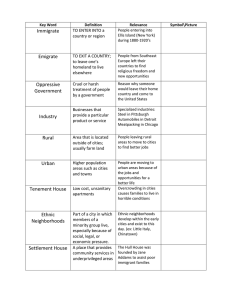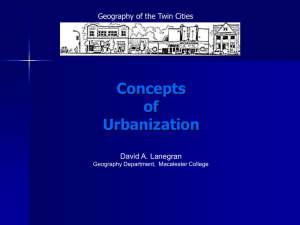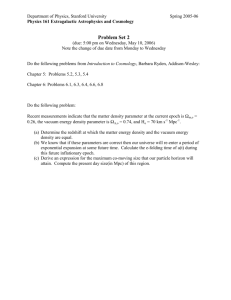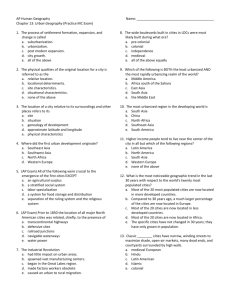AP PREP The Changing Nature of Cities and Urban Culture
advertisement
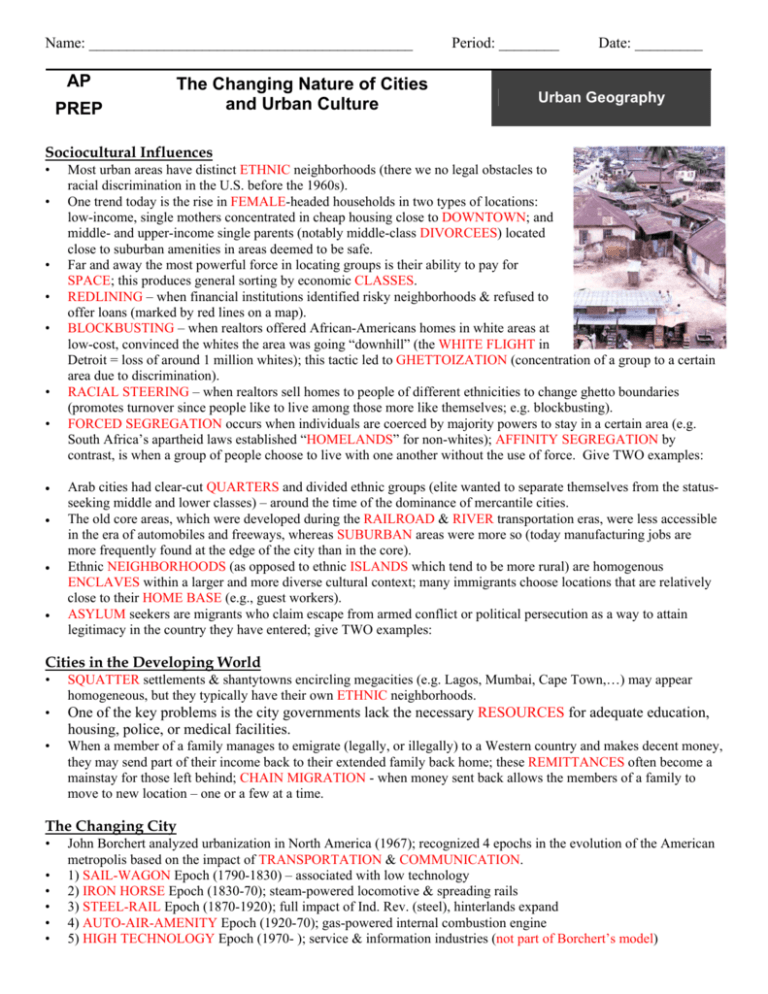
Name: ___________________________________________ AP PREP The Changing Nature of Cities and Urban Culture Period: ________ Date: _________ Urban Geography Sociocultural Influences • • • • • • • • • • • Most urban areas have distinct ETHNIC neighborhoods (there we no legal obstacles to racial discrimination in the U.S. before the 1960s). One trend today is the rise in FEMALE-headed households in two types of locations: low-income, single mothers concentrated in cheap housing close to DOWNTOWN; and middle- and upper-income single parents (notably middle-class DIVORCEES) located close to suburban amenities in areas deemed to be safe. Far and away the most powerful force in locating groups is their ability to pay for SPACE; this produces general sorting by economic CLASSES. REDLINING – when financial institutions identified risky neighborhoods & refused to offer loans (marked by red lines on a map). BLOCKBUSTING – when realtors offered African-Americans homes in white areas at low-cost, convinced the whites the area was going “downhill” (the WHITE FLIGHT in Detroit = loss of around 1 million whites); this tactic led to GHETTOIZATION (concentration of a group to a certain area due to discrimination). RACIAL STEERING – when realtors sell homes to people of different ethnicities to change ghetto boundaries (promotes turnover since people like to live among those more like themselves; e.g. blockbusting). FORCED SEGREGATION occurs when individuals are coerced by majority powers to stay in a certain area (e.g. South Africa’s apartheid laws established “HOMELANDS” for non-whites); AFFINITY SEGREGATION by contrast, is when a group of people choose to live with one another without the use of force. Give TWO examples: Arab cities had clear-cut QUARTERS and divided ethnic groups (elite wanted to separate themselves from the statusseeking middle and lower classes) – around the time of the dominance of mercantile cities. The old core areas, which were developed during the RAILROAD & RIVER transportation eras, were less accessible in the era of automobiles and freeways, whereas SUBURBAN areas were more so (today manufacturing jobs are more frequently found at the edge of the city than in the core). Ethnic NEIGHBORHOODS (as opposed to ethnic ISLANDS which tend to be more rural) are homogenous ENCLAVES within a larger and more diverse cultural context; many immigrants choose locations that are relatively close to their HOME BASE (e.g., guest workers). ASYLUM seekers are migrants who claim escape from armed conflict or political persecution as a way to attain legitimacy in the country they have entered; give TWO examples: Cities in the Developing World • SQUATTER settlements & shantytowns encircling megacities (e.g. Lagos, Mumbai, Cape Town,…) may appear homogeneous, but they typically have their own ETHNIC neighborhoods. • One of the key problems is the city governments lack the necessary RESOURCES for adequate education, housing, police, or medical facilities. • When a member of a family manages to emigrate (legally, or illegally) to a Western country and makes decent money, they may send part of their income back to their extended family back home; these REMITTANCES often become a mainstay for those left behind; CHAIN MIGRATION - when money sent back allows the members of a family to move to new location – one or a few at a time. The Changing City • • • • • • John Borchert analyzed urbanization in North America (1967); recognized 4 epochs in the evolution of the American metropolis based on the impact of TRANSPORTATION & COMMUNICATION. 1) SAIL-WAGON Epoch (1790-1830) – associated with low technology 2) IRON HORSE Epoch (1830-70); steam-powered locomotive & spreading rails 3) STEEL-RAIL Epoch (1870-1920); full impact of Ind. Rev. (steel), hinterlands expand 4) AUTO-AIR-AMENITY Epoch (1920-70); gas-powered internal combustion engine 5) HIGH TECHNOLOGY Epoch (1970- ); service & information industries (not part of Borchert’s model) Urban America • • • • • • • The INNER CITY consists of the rings and sectors between the CBD and the suburbs; SPRAWL- haphazard growth or extension outward, especially along the outskirts of a city. DEGLOMERATION – industrial de-concentration in response to technological changes and/or increasing costs (e.g. energy, land rent). GENTRIFICATION – rehabilitation of inner city housing w/ favorable locations to CBD & employment COMMERCIALIZATION – attracts tourism & business through advertising and aggressive sales; does NOT necessarily result in PERMANENT residents (e.g. “RiverFront” in Fort Lauderdale); best way to revive the city core is still Wellston, St. Louis – site of deglomeration to attract new RESIDENTS who have a stake in the city’s future. “Suburbia” has now led to the establishment of more self-sufficient entities (e.g. EDGE CITIES); many are no longer an appendage to the central city (see the URBAN REALMS model). The 1990s was the 1st decade since WWII that inner cities have grown in the U.S. (according to the 2000 Census); there are still problem-ridden zones (e.g. loss of TAX revenues - from residents moving to suburbs). CENSUS TRACT - the most commonly used level of census information (approximate scale of an urban neighborhood; ~4,000 inhabitants); usually contains several NEIGHBORHOODS (a political unit, such as a city, town, or village, incorporated for local self-government). Canadian & European Cities • Canadian cities are much less DISPERSED than American cities. • More people of the high & middle class reside in the central city (this results in a better TAX base & also results in better services due to more revenues). • SUBURBS do exist, but they are not as wealthy or as far from the central city as in U.S. • AGGLOMERATION (nucleation) – clustering by commercial enterprises for mutual advantage (very common especially in Europe). • SPECIALIZATION – e.g. Manchester (textiles), Birmingham (steel). • European cities are typically much older than most cities in the U.S., but most have still gone through the INDUSTRIAL Revolution (from MERCANTILE to manufacturing cities). • Many European cities have a zone of open country w/ some scattered towns; this region is known as a [Metropolitan] GREENBELT. • These regions typically LIMIT urban sprawl and suburbanization; this is as much a product of necessity as it is of convenience (e.g. the cost of gas can be 3 times higher than in the U.S.!). • Most EASTERN European cities are even more compact (sustained the dominance of the central city); many Eastern European cities were affected by the U.S.S.R. and the effects of COMMUNISM. • The cities almost always had MICRODISTRICTS (w/ a huge, dominant square at the center of the city, w/ radiating avenues flanked by basic apartment blocks); because of these zones, they had no need for CBDs; microdistricts had workplaces, schools, recreation areas, etc… Urbanization: Pro & Con • PRO: fewer PEOPLE in rural areas – better for forests, soil, wildlife,…, lower FAMILY sizes, better EDUCATION & HEALTH CARE; greater opportunities for TECHNOLOGICAL development. • CON: o 1) Hazards of SITE – outlying areas more susceptible to landslides, floods, storms, earthquakes,…; o 2) Loss of LAND – farmland lost (US = 1 million acres/yr.; China = 3x as much); o 3) Changed Land COVER – natural landscape becomes more CULTURAL (pavement, buildings,…); less rainfall, more pollutants; o 4) Impact of POLLUTION – growing volumes of contaminants (in air, water, and soil); Mexico City, Delhi, Bangkok are most SMOG-ridden; o 5) Production of WASTE – lack of sewer facilities (>3 million w/o in Mexico City); burning garbage heaps; o 6) Larger Demand for WATER – much higher than in rural areas; riverfront cities create pollution as well; o 7) Changing CONSUMPTION habits – urban dwellers use more energy, change diets (meat), dress, and recreation habits.
